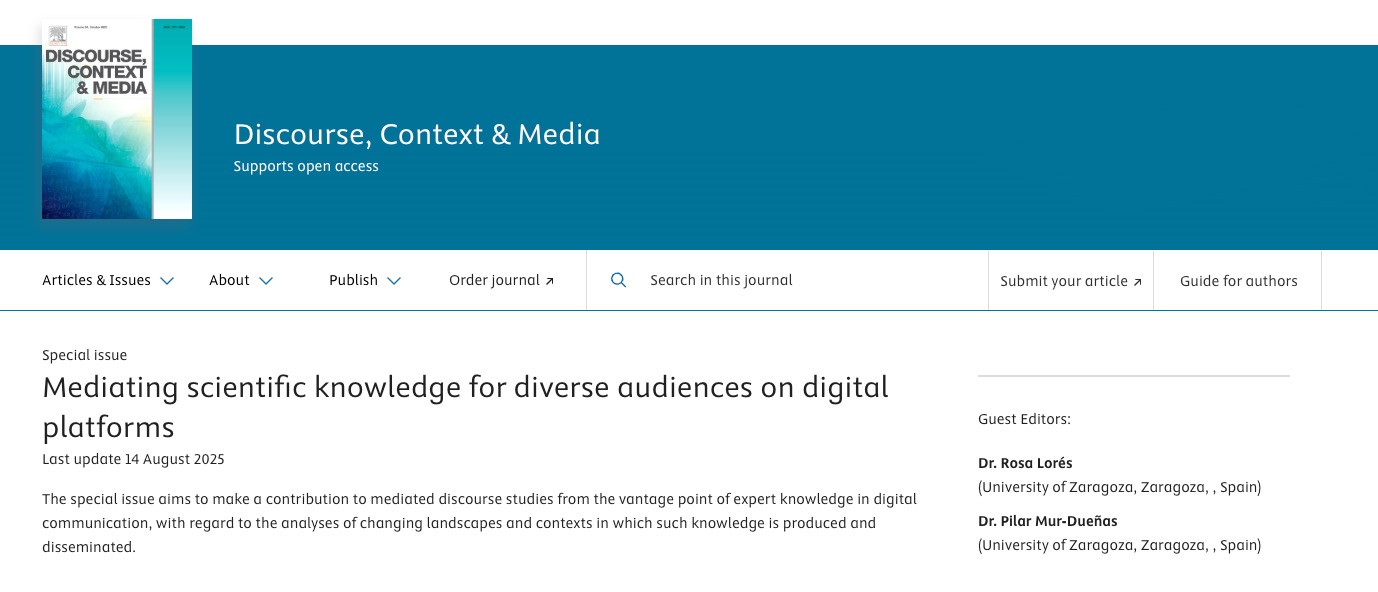New special issue edited by Dr Rosa Lorés and Dr Pilar Mur-Dueñas in Discourse, Context & Media
Our team members Dr Rosa Lorés and Dr Pilar Mur-Dueñas have edited a special issue available in Discourse, Context & Media, titled “Mediating scientific knowledge for diverse audiences on digital platforms”. This issue comprises eight articles in total – including the editorial–, which bring to the fore key ideas and fresh analytical approaches to the study of the production and dissemination of expert knowledge.

After the editorial article by Lorés and Mur-Dueñas, the special issue begins with a contribution by Carter-Thomas and Rowley-Jolivet on “Transmedial recontextualization of new scientific research claims“, where they track how the knowledge reported on RAs is circulated across three other genres targeting different audiences.
Afterwards, the article by Dontcheva-Navratilova, titled “We want you to be informed’: Rhetorical and pragmatic strategies for recontextualising scientific knowledge in biology video abstracts” puts forward a three-fold typology of biology VAs, and identifies and analyses the distribution of framing-oriented and engagement-enhancing rhetorical strategies in each type.
Engberg and Maier‘s article centres on “Understanding multimodal science slam performances: How expert knowledge is built and transferred through digital ludic recontextualization“, by combining theoretical lenses that draw on the knowledge communication approach, multimodality and genre and ludic learning.
In “Digital crossings: A case study of a knowledge mobilisation approach for translating research into practice“, Loh, Lim and Ow present a case study featuring education research in Singapore to examine how the discourse of research is selectively relocated, reaccentuated and related to the discourse of practice.
Next, Luzón and Albero-Posac contribute a paper titled “Disseminating research results in The Conversation: An analysis of comprehensibility strategies” by adopting a multimodal perspective to the study of recontextualisation, discussing how comprehensibility is boosted through verbal and non-verbal strategies.
“The use of emojis in X/Twitter for research recontextualization” is explored in a corpus study by Murillo, where she applies the framework of relevance theory to the analysis of utterance interpretation through emojis.
The last article, written by Warchał, focuses on “Facts, hopes, and fears: Recontextualising experimental drug results for diverse audiences“. Through a case study about the online uptake of results from a trial for an Alzheimer’s drug, she examines the modifications of knowledge claims when being communicated to diverse digital audiences.
We believe that this special issue can help advance knowledge about the changing landscapes, contexts and strategies related to mediated discourse studies, especially regarding the digital communication of expert knowledge.
